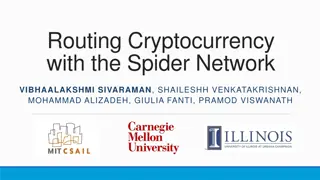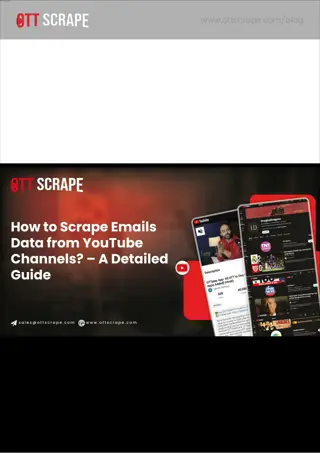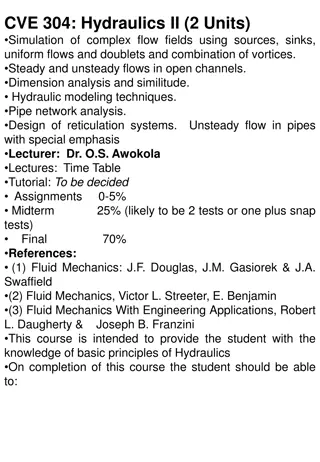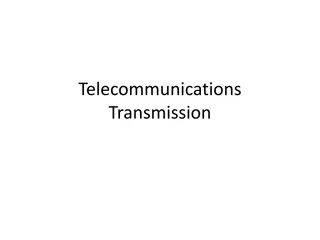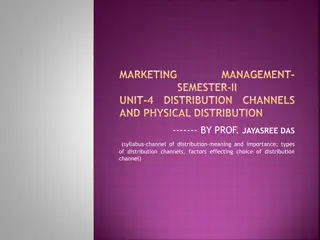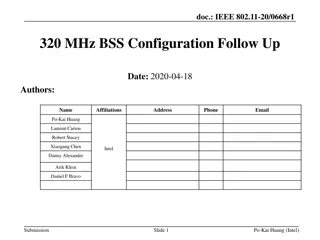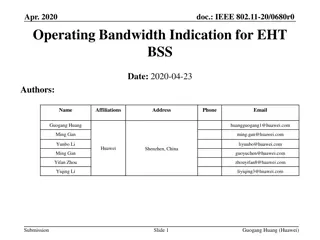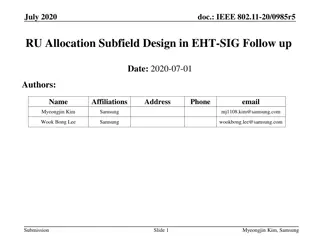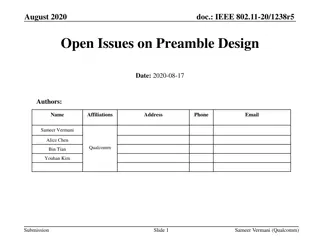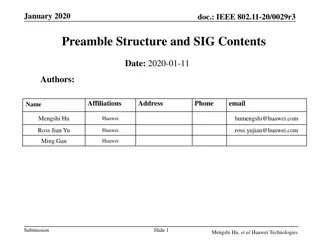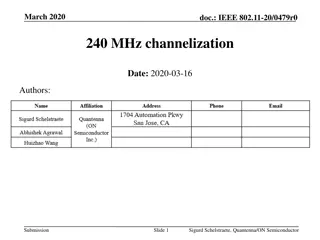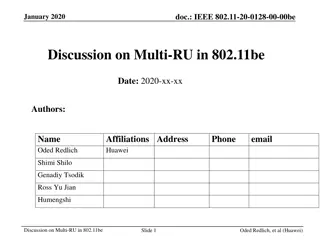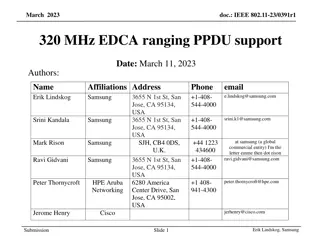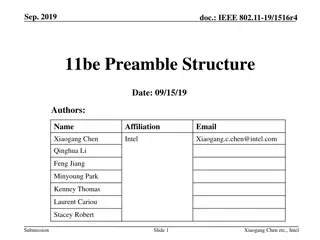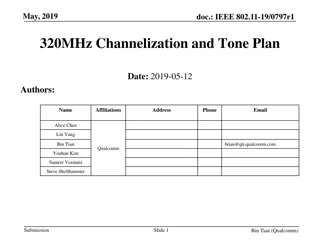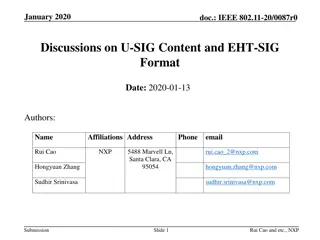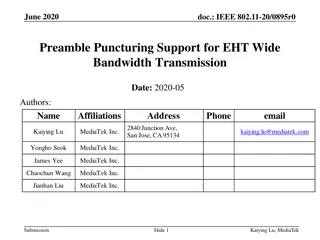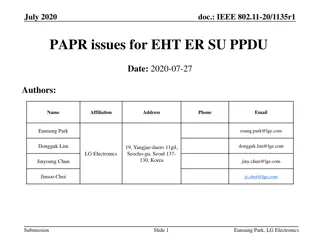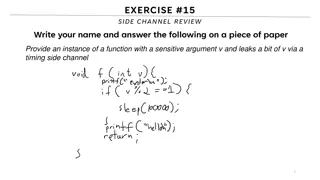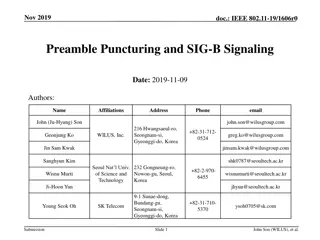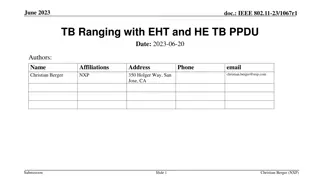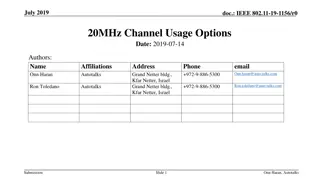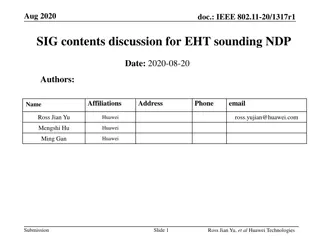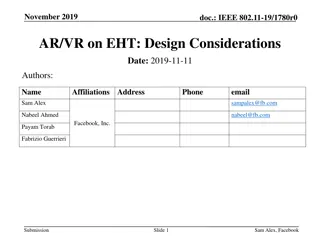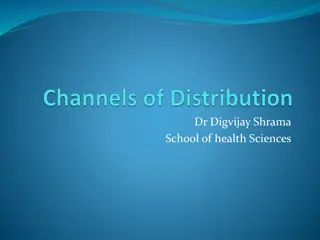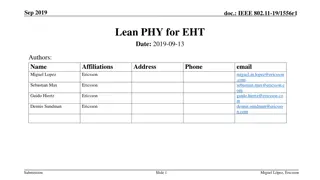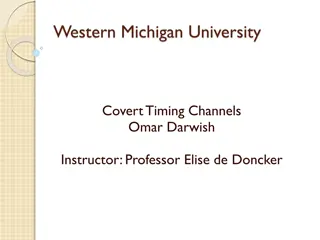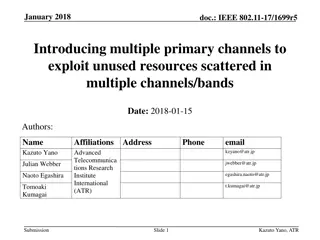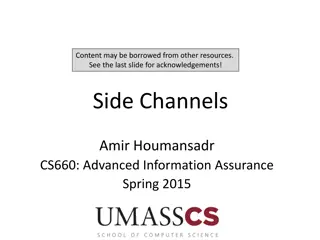Sales Leadership Management
Marketing channel decisions play a crucial role in the success or failure of products in both B2C and B2B markets. This chapter explores the importance of effective channel management, types of channels, the role of intermediaries in streamlining transactions, and the distinction between marketing c
0 views • 18 slides
Understanding Payment Channels in Cryptocurrency Networks
Explore the concept of payment channels in cryptocurrency networks to address scalability issues and reduce transaction costs. Learn how these channels enable fast and cost-effective transactions by minimizing blockchain usage. Discover the innovative solutions proposed by experts in the field.
3 views • 37 slides
How to Scrape Emails Data from YouTube Channels
Learn to ethically scrape email data from YouTube channels using Python libraries and YouTubes Data API for targeted marketing. \n\nknow me>>\/\/ \/scrape-emails-data-from-youtube-channels.php\n
0 views • 10 slides
How to Scrape Emails Data from YouTube Channels
Learn to ethically scrape email data from YouTube channels using Python libraries and YouTubes Data API for targeted marketing. \n\nknow me>>\/\/ \/scrape-emails-data-from-youtube-channels.php\n
1 views • 10 slides
How to Scrape Emails Data from YouTube Channels (1)
Learn to ethically scrape email data from YouTube channels using Python libraries and YouTubes Data API for targeted marketing. \n\nknow me>>\/\/ \/scrape-emails-data-from-youtube-channels.php\n
1 views • 10 slides
How to Scrape Emails Data from YouTube Channels (1)
Learn to ethically scrape email data from YouTube channels using Python libraries and YouTubes Data API for targeted marketing. \n\nknow me>>\/\/ \/scrape-emails-data-from-youtube-channels.php\n
0 views • 10 slides
Enhancing Secondary Channel Usage in IEEE 802.11 Standards
This document, IEEE 802.11-23/1935r1, delves into the intricacies of secondary channel usage within the context of IEEE 802.11 standards. Key topics covered include discussions on RU index, BW negotiation in secondary channels, methods to ensure medium synchronization when transitioning back to prim
0 views • 14 slides
Understanding Hydraulics II: Simulation and Analysis in Open Channels
Dive into Hydraulics II to explore complex flow fields, dimensional analysis, pipe network analysis, and design of reticulation systems. Learn about steady and unsteady flows in open channels, Chezy's and Manning's equations, and the different flow regimes in open channels. Gain insights into unifor
4 views • 5 slides
Understanding Telecommunications Transmission Systems
Transmission systems in telecommunications provide circuits between network nodes using channels for bidirectional communication. Channels can range from simple audio circuits to complex satellite systems. Signals can be analog or digital, each with its unique characteristics. Bandwidth is crucial f
0 views • 32 slides
Understanding Distribution Channels in Marketing Management
Distribution channels play a vital role in moving products from producers to consumers efficiently. This involves various middlemen and processes such as physical distribution and logistics. By understanding the types of distribution channels and factors affecting their choice, businesses can enhanc
7 views • 10 slides
IEEE 802.11-20/0668r1: EHT BSS Configuration Proposal
The document discusses the configuration of a 320 MHz BSS in the context of 6 GHz regulations, focusing on EHT operation elements such as channel width indication, CCFS principles, and BSS advertisement settings. It proposes design principles for managing legacy and EHT STA operations, emphasizing s
0 views • 14 slides
Bandwidth Indication for EHT BSS in IEEE 802.11-20/0680r0
This IEEE document discusses the proposal to use an Enhanced High Throughput (EHT) operation element to indicate operating bandwidth for EHT Basic Service Sets (BSS). It suggests methods for indicating channel configurations, punctured channels, and channel width for EHT stations. The goal is to ena
0 views • 15 slides
Designing 9-Bit RU Allocation Subfield for EHT Trigger Frame in IEEE 802.11-20
IEEE 802.11-20/1845r2 presents a proposal for enhancing the RU allocation subfield design in the EHT Trigger frame to accommodate bandwidth support up to 320MHz and multiple RU or MRU allocations for UL MU transmissions in the 11be standard. The modification addresses inconsistencies in MRU mapping
0 views • 34 slides
IEEE 802.11-20/0985r5 RU Allocation Subfield Design in EHT-SIG
The document discusses the design of subfields in EHT-SIG for RU allocation in IEEE 802.11be, focusing on reducing overhead by considering supported large-size MRU combinations. It addresses concerns on entries overhead in the RU allocation subfield table and the clarity of support for specific MRU
3 views • 24 slides
IEEE 802.11-20/1238r5 August 2020 Preamble Design Open Issues
In these slides, designs for U-SIG content & overflow and EHT-SIG design are proposed. The focus is on punctured channel indication design with the aim of conveying puncturing patterns efficiently while keeping signaling overhead low. The proposal includes a 6-bit field for puncturing information, a
1 views • 41 slides
IEEE 802.11-20/0029r3 Preamble Structure and SIG Contents Overview
The document dated January 2020 discusses the preamble structure and SIG contents, focusing on EHT-SIG in IEEE 802.11-20/0029r3 amendment. It covers the introduction of U-SIG, EHT-SIG format, EHT.PPDU types, and EHT-SIG design for MU PPDU. The discussion includes the necessity of accommodating overf
3 views • 22 slides
IEEE 802.11-20/0479r0 240 MHz Channelization Options
The document discusses agreements on 240 MHz channelization in IEEE 802.11-20/0479r0, presenting three options: contiguous non-overlapping channels, any combination of three consecutive 80 MHz channels, and puncturing of a 320 MHz channel. Various considerations and questions are raised regarding th
0 views • 12 slides
Discussion on Multi-RU Allocation in IEEE 802.11be Standard
In January 2020, a discussion took place on the allocation of multiple Resource Units (RUs) to a single Station (STA) in the IEEE 802.11be standard. The proposal suggested categorizing RUs into small and large types, avoiding aggregation across multiple 20MHz channels. It emphasized assigning a sing
2 views • 29 slides
Proposal for EHT 320 MHz PPDU Support in EDCA Ranging for IEEE 802.11-23/0391r1
The document outlines a proposal to enable EHT 320 MHz PPDU support for EDCA ranging in IEEE 802.11-23/0391r1. It discusses the implementation of FTM legacy ranging, the importance of wider bandwidths, and the necessary changes in the standard to incorporate this support. The proposal aims to enhanc
0 views • 6 slides
IEEE 802.11-19/1516r4: 11be Preamble Structure Overview
The document discusses the design and structure of the 11be preamble in IEEE 802.11-19/1516r4. It emphasizes reusing existing functions from previous WiFi generations and focusing on features that enhance user experience. The preamble includes elements such as Pre-EHT preamble, EHT preamble, legacy
0 views • 13 slides
Channelization and Tone Plan Discussion for 320MHz EHT
IEEE 802.11-19/0797r1 discusses the channelization and tone plan design for 320MHz in EHT (11be). The slides cover the benefits of a 320MHz channel, double peak throughput, various BW modes, existing and new configurations, and proposals for tone plans to maximize efficiency. Detailed considerations
0 views • 10 slides
IEEE 802.11-20/0087r0 Discussions on U-SIG Content and EHT-SIG Format
In January 2020, NXP presented a document discussing the U-SIG content and EHT-SIG format within the IEEE 802.11-20/0087r0 framework. The document elaborates on the structure and encoding of U-SIG fields, version-dependent and version-independent bits, as well as the EHT-SIG structure for SU/MU tran
0 views • 10 slides
Efficient Preamble Puncturing Support for IEEE 802.11 EHT Wide Bandwidth Transmission
The IEEE 802.11-20/0895r0 document addresses the introduction, issues, motivation, and support for preamble puncturing in EHT transmissions. It focuses on optimizing resource allocation while facilitating flexible preamble puncturing for OFDMA transmission in wide bandwidth scenarios, such as managi
0 views • 14 slides
PAPR Issues in EHT-ER-SU PPDU for 6GHz Wi-Fi Systems
Introduction of a new PPDU type (EHT-ER-SU) for extending transmission range in 6GHz Wi-Fi systems has led to PAPR issues due to frequency-duplicated data, impacting indoor and outdoor usage. Proposed methods aim to reduce PAPR, addressing concerns for indoor STAs and outdoor support in high-power s
0 views • 10 slides
Understanding Side Channels in Software Security
This content delves into the topic of side channels in software security, focusing on the leakage of sensitive information through timing side channels. It discusses the concept of covert channels, reference monitors, limitations of analysis, and prevention strategies to mitigate the risks associate
0 views • 25 slides
Enhancing Support for Wider Bandwidth OFDMA in IEEE 802.11 Networks
The document discusses the implementation of Selective Spatial Transmission (SST) and Dynamic Subband Operation (DSO) to enable wider bandwidth OFDMA in IEEE 802.11be and 802.11bn standards. It covers enhancements for 80MHz, 160MHz, and 320MHz EHT DL and UL OFDMA transmissions, emphasizing the benef
0 views • 18 slides
Enhancing Spectrum Efficiency with Low Complexity Erasure Codes in IEEE 802.11 Document
This document delves into the implementation of erasure codes for content channels in IEEE 802.11 systems. By utilizing erasure codes, spectrum efficiency can be boosted without significantly increasing the complexity of encoding and decoding processes. The discussion also covers the duplication of
0 views • 20 slides
IEEE 802.11-19/1606r0 Preamble Puncturing and SIG-B Signaling
EHT, an enhancement to the IEEE 802.11 standard, aims to improve channel access in dense environments using wider bandwidth operation. This document discusses the design considerations for SIG-B content channels and preamble puncturing in the context of EHT's support for 320MHz bandwidth and multipl
0 views • 14 slides
Understanding Ion Channels in Cell Communication
Ion channels play a crucial role in cell communication by allowing ions to pass through cell membranes, controlling various cellular functions. Their high transport rate and electrochemical gradient differentiate them from other ion transporter proteins. Ion channels have diverse biological roles, i
0 views • 26 slides
IEEE 802.11-23/1067r1 TB Ranging with EHT and HE TB PPDU Overview
This document discusses the use of 320 MHz bandwidth in TB ranging for IEEE 802.11-23/1067r1, focusing on EHT and HE TB frames. It examines the decision trees regarding the use of EHT TB ranging NDP, limitations on frame mixing, and bandwidth reduction for Location Measurement Report (LMR). Key cons
0 views • 8 slides
IEEE 802.11-19-1156/r0: 20MHz Channel Usage Options
This document discusses the utilization of 20MHz channels in IEEE 802.11-19-1156/r0 standard, focusing on high-bandwidth use-cases such as cooperative perception. It addresses the impact of concurrent transmission in adjacent channels, the importance of predetermined sub-channels for efficient servi
0 views • 14 slides
Proposal for Improved Channel Access Efficiency in IEEE 802.11 Networks
The proposal addresses the inefficiencies in utilizing secondary channels in IEEE 802.11 networks, aiming to enhance access to wideband channels (>20 MHz) when the primary channel is busy. It introduces a mechanism for APs and STAs to access available secondary channels while the primary channel is
0 views • 7 slides
IEEE 802.11-20/1317r1 EHT-SIG Proposal Discussion
The document discusses EHT-SIG for single-user and sounding NDP in IEEE 802.11-20/1317r1, focusing on overflow bits, user fields, CRC, and tail formats. It covers the format details, subfields, and overhead compared to HE sounding, proposing specific bit allocations for different elements. The EHT-S
0 views • 16 slides
Design Considerations for AR/VR on EHT in IEEE 802.11-19/1780r0
Explore the detailed design considerations and use cases for AR/VR applications on EHT in the IEEE 802.11-19/1780r0 document. The document covers various aspects such as KPIs, timing diagrams, simulation results, comparisons with 5GNR, source of latency in 802.11, and suggestions for optimizing perf
0 views • 15 slides
Understanding Channels of Distribution in Business
Channels of Distribution play a crucial role in the movement of goods and services from manufacturers to end consumers. This involves the allocation and transfer of products through various intermediaries, impacting sales and availability. The types of channels include Direct, Indirect, and Hybrid c
0 views • 20 slides
Relevance of Lean PHY for EHT in 6 GHz
Discussing the importance of a Lean PHY for EHT in 6 GHz to improve spectrum efficiency and reduce overhead. Introducing the Low Throughput PHY as a potential solution, highlighting its benefits compared to existing options like 802.11a. Measurement results show the impact and potential for enhancin
0 views • 14 slides
Understanding Covert Timing Channels in Network Security
Covert timing channels are a method of leaking sensitive information across networks by violating security policies. These channels rely on conveying information through packet arrival patterns rather than the contents of the packets. Military applications, detection by USA government agencies, and
0 views • 26 slides
Multi Division in Networking: Access Methods & Duplexing Techniques
Reviewing the concepts of multi-division in networking, this content delves into the need for multiple control channels, challenges in sharing channels, techniques like ALOHA and CSMA, and the importance of control channels and data channels. It explores access methods for control and data channels,
0 views • 20 slides
Enhancing Wireless LAN Throughput with Multiple Primary Channels
This document discusses the need for increasing system throughput in wireless LAN networks due to the growing demand for WLAN traffic. By introducing multiple primary channels, unused resources scattered across various channels can be exploited to improve quality of service and enhance transmission
0 views • 20 slides
Understanding Side Channels and Information Hiding Techniques in Advanced Information Assurance
This content covers various aspects of advanced information assurance, focusing on side channels and information hiding techniques such as digital watermarking, steganography, and covert channels. It discusses the concept of side-channel attacks, types of system and network channels, fault attacks,
0 views • 24 slides

